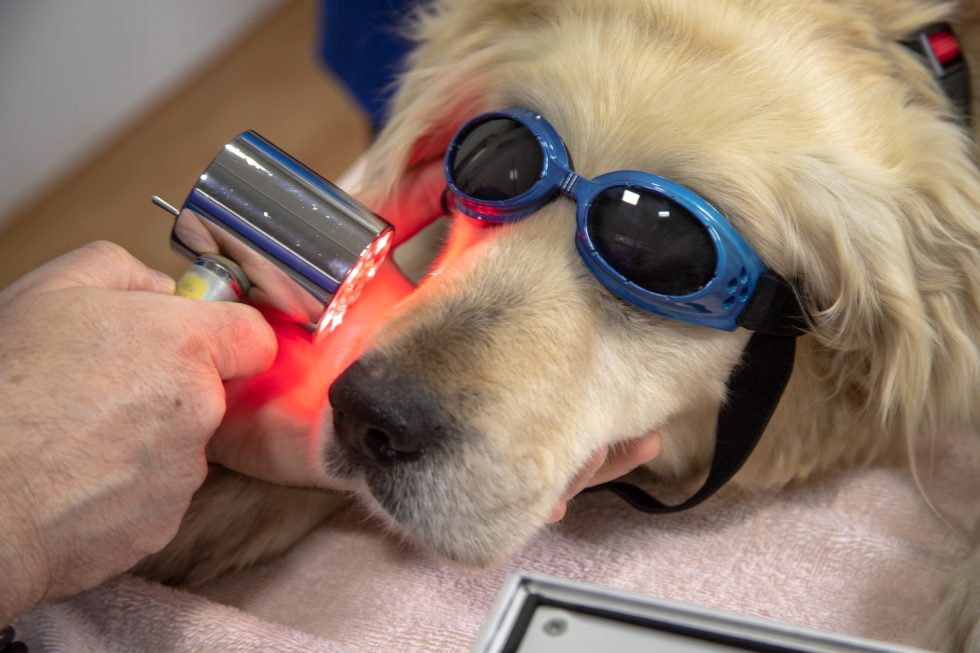How Red Light Therapy Can Improve Your Dog's Overall Wellness
Red Light Therapy has become a promising alternative for enhancing canine health. This non-invasive therapy stimulates cellular task and promotes recovery in dogs experiencing different disorders. Lots of family pet owners report visible benefits, consisting of discomfort relief and enhanced mobility. Nonetheless, recognizing the underlying devices and prospective applications is essential. What certain conditions can it deal with, and exactly how can it be securely integrated into a pet's care regimen? The solutions may surprise you.
Recognizing Red Light Therapy: What It Is and Exactly how It Works
Although red light therapy has actually obtained popularity in human medication, its application for pet dogs is increasingly identified for its prospective advantages. This non-invasive treatment uses specific wavelengths of light, normally in the red and near-infrared range, to stimulate cellular function. The underlying principle entails the absorption of light by mitochondria, which increases ATP manufacturing and enhances cellular metabolic rate.
Therefore, red light therapy advertises boosted circulation and help in cells repair work. The therapy is supplied through gadgets such as lasers or LED panels, which can be routed at specific areas of a pet's body. Treatment sessions are usually short, making it a practical alternative for family pet proprietors.
Understanding this modern technology's systems can aid caregivers make informed choices regarding their pet's healthcare. As research study continues to develop, the passion in red light therapy as a corresponding treatment modality for numerous canine conditions is most likely to expand.

Benefits of Red Light Therapy for Dogs
Red light therapy uses several significant advantages for canines, including effective discomfort relief and an increased healing procedure. This therapy can improve mobility and adaptability, making it especially beneficial for aging or wounded animals. As even more pet proprietors look for alternate therapies, understanding these benefits ends up being progressively crucial.
Pain Relief Applications
Several pet dog owners are transforming to red light therapy as an appealing service for alleviating discomfort in their family pets. This non-invasive therapy utilizes certain wavelengths of light to pass through the skin, promoting cellular task and lowering swelling. Dogs struggling with chronic conditions such as arthritis, hip dysplasia, or post-surgical pain might experience substantial alleviation via this therapy. Studies indicate that red light therapy can boost blood flow, aiding to supply vital nutrients to influenced areas, better contributing to discomfort decrease. Additionally, it may assist to lower the reliance on pharmaceutical painkiller, which usually come with unfavorable side results. As a result, numerous vets are significantly recommending red light therapy as a effective and safe alternative for handling discomfort in pet dogs.

Accelerated Healing Process
The advantages of red light therapy prolong beyond pain relief, playing an essential role in speeding up the healing process for pet dogs. This ingenious treatment advertises mobile regeneration, stimulating the manufacturing of ATP, which boosts energy availability for healing cells. Furthermore, red light therapy enhances blood circulation, bring about boosted oxygen and nutrient distribution to harmed areas. This heightened flow not only help in faster healing yet additionally decreases inflammation, a common obstacle to healing. Furthermore, the therapy encourages collagen manufacturing, crucial for cells fixing and regrowth. Overall, by promoting these biological procedures, red light therapy greatly shortens recuperation times, allowing pet dogs to return to their typical tasks faster and with higher vigor.
Boosted Wheelchair and Flexibility
Boosted mobility and versatility are substantial benefits of red light therapy for pet dogs, specifically for those suffering from joint discomfort or rigidity. This non-invasive treatment uses specific wavelengths of light to pass through tissues, promoting enhanced flow and reducing inflammation. Because of this, pet dogs commonly experience alleviation from discomfort linked with arthritis, hip dysplasia, or post-surgical recovery. Regular sessions can stimulate cellular repair and improve muscular tissue feature, permitting pets to regain their natural series of movement. Proprietors have actually reported visible renovations in their pets' capacity to run, jump, and participate in tasks they when enjoyed (Red Light Therapy Dogs). Eventually, red light therapy not just helps minimize discomfort however also adds to a more energetic and fulfilling way of living for dogs, enhancing their additional reading general lifestyle
Conditions That Can Be Cured With Red Light Therapy
Red light therapy has obtained appeal in different fields, its application in vet treatment, particularly for canines, has shown promise in treating a range of conditions. This non-invasive treatment method is thought to assist in alleviating discomfort and swelling associated with arthritis, assisting older pets regain flexibility. Furthermore, it has been utilized to help in the healing of injuries, burns, and surgical cuts, promoting faster healing times.
Skin problems, such as dermatitis and hot areas, may likewise react positively to red light therapy, lowering irritability and encouraging much healthier fur development. Additionally, the therapy can be useful for dogs dealing with problems like hip dysplasia, tendon website link injuries, and muscle stress. By boosting cellular repair service and improving circulation, red light therapy uses a holistic technique to improving the total wellness of pets, offering alleviation and promoting a far better lifestyle.
The Scientific Research Behind Red Light Therapy
Red light therapy runs on the principle of photobiomodulation, which includes the application of specific wavelengths of light to promote cellular processes. These wavelengths, typically varying from 600 to 1000 nanometers, penetrate the skin and are taken in by mitochondria, the energy-producing parts of cells. This absorption improves ATP manufacturing, causing increased energy schedule for cellular functions.

Studies recommend that red light therapy may likewise modulate immune responses and assistance general cellular health. By harnessing these organic mechanisms, red light therapy provides a non-invasive treatment alternative that can contribute significantly to a pet's well-being and recuperation from numerous conditions.
Just How to Integrate Red Light Therapy Into Your Dog's Regular
Integrating red light therapy right into a pet dog's routine can be a straightforward procedure, supplied that family pet owners approach it with treatment and uniformity. Initially, picking a suitable gadget is essential, as options variety from portable units to larger panels. Owners must begin by introducing the therapy gradually, permitting their dogs to adapt to the light exposure. Procedure can be arranged for around 10 to 20 minutes, preferably 2 to three times a week, relying on the dog's demands and the recommendations of a vet
Setting a comfortable setting Visit Your URL is vital; making use of a silent room where the canine feels kicked back can boost the experience. Throughout the sessions, proprietors can engage their animals with relaxing voices or mild stroking to produce a relaxing ambience. Checking the dog's reaction is critical to guarantee the therapy is satisfying and beneficial, inevitably assisting to boost their overall wellness.
Safety And Security Considerations and Measures for Red Light Therapy
When considering red light therapy for pets, safety ought to always be a leading concern to guarantee a positive experience. Pet proprietors need to get in touch with a vet before beginning any kind of therapy, particularly for pets with pre-existing problems or those taking medicines. It is important to choose gadgets especially developed for pets, as human gadgets might not be ideal.
Correct eye defense is essential; both the pet dog and the handler ought to wear goggles to protect their eyes from prospective damage. Furthermore, sessions must be kept track of closely to prevent overexposure. It is recommended to start with shorter sessions and progressively raise period based on the dog's feedback.
Proprietors ought to also observe their pets for any kind of indications of pain or negative reactions throughout and after treatment. By following these security considerations, red light therapy can be a advantageous and secure option for improving a canine's wellness.
Regularly Asked Questions
Exactly how Commonly Should I Use Red Light Therapy on My Dog?

Can Red Light Therapy Change Standard Veterinary Therapies?
Red light therapy must not change standard veterinary therapies. While it might enhance therapies by advertising healing and reducing discomfort, consulting a vet continues to be crucial for detailed treatment and attending to hidden health and wellness issues in dogs.
Exist Any Type Of Adverse Effects of Red Light Therapy for Dogs?
Red light therapy for canines generally has marginal adverse effects, such as momentary skin inflammation or warmth at the therapy site. Many dogs endure the therapy well, however keeping an eye on for any type of unusual reactions is suggested.
What Is the Perfect Duration for each and every Red Light Therapy Session?
The suitable duration for each red light therapy session commonly varies from 10 to 20 minutes, depending on the pet's particular needs and problem. Consultation with a vet is suggested to customize the treatment suitably.
Is Red Light Therapy Appropriate for All Canine Breeds?
Red light therapy is usually ideal for many dog breeds. Private wellness problems and sensitivities might influence its applicability. Consulting a veterinarian ensures the therapy is safe and valuable for each and every particular dog.
Lots of dog proprietors are turning to red light therapy as an encouraging service for alleviating pain in their pet dogs. Improved movement and adaptability are significant advantages of red light therapy for dogs, especially for those enduring from joint discomfort or stiffness. Red light therapy operates on the principle of photobiomodulation, which entails the application of particular wavelengths of light to promote mobile procedures. Research suggests that red light therapy can promote healing, lower swelling, and alleviate discomfort in pet dogs. Red light therapy for canines generally has minimal side effects, such as short-term skin inflammation or warmth at the treatment website.